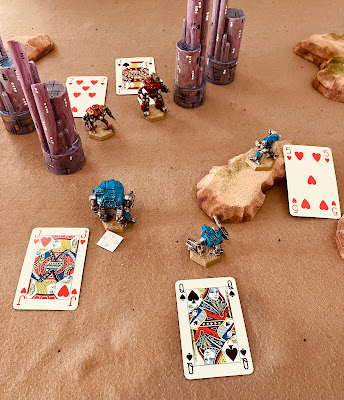To take a break from my mech campaign, I decided to try something different and purchased a print-and-play game from Wargame Vault. This was my first time picking up one of these games, and with limited wargaming options on hand until we move into our house, I figured it was worth trying one out.
The game I chose was “Battle of Sekigahara Game” by The Historical Game Company and Blue Panther LLC. I was intrigued by this game because uses event cards to determine the number of moves and attacks each player can make during their turn, along with special events that affect play. The events can range from combat or movement benefits, to major shifts in the battle like an allied clan switching sides.
The rules are straightforward and fit easily onto four pages. The only thing that tripped me up in my first game was remembering the defensive fire phase, where the opponent can shoot with missile units (arquebus and bow) right after movement and before the combat phase. I found the card mechanics with their events work well when playing solo adding a level of uncertainty.
 |
| A recent print and play purchase |
After purchasing and downloading the game, the next step was printing. Since I don’t have access to a printer and needing the map on A3 paper (approximately 11 x 17 inches) I decided to go with an online printing service. The process proved to be quite simple: I just uploaded the rules, counters, cards, and map, and for each selected the paper size and quality. For example I had the map printed on their highest quality paper so it will be more durable. The printing arrived two business days later, not long to wait.
Once the printouts arrived, I glued the counters onto card stock using a glue stick, then lined up and stuck on the counter backs. Finally once the glue was fully dry I cut them out. As for the cards, they came on one sheet of paper with the faces on one side and the backs on the other which all lined up nicely. These I covered with clear contact plastic, front and back, before cutting them out. This gave the cards some extra thickness along with durability. There are no pictures of this process as it is quite tricky putting the contact plastic on, one mistake and it all turns to custard.
 |
| The printed front and back of the counters are glued to a piece of card and cut out. |
 |
| The completed cards. The printed cards came on one sheet of paper with the faces on one side and the backs on the other which all lined up nicely. These were covered with clear contact plastic, then cut out. |
So far, I have managed to play one game, where the Eastern Army under Tokugawa Ieyasu quickly defeated the Western Army under Ishida Mitsunari. Although the game ended up being a one-sided affair, probably due to my erratic tactics, I will definitely be playing some more games in over the next few weeks as a change from my mech games. One feature of the game I liked is each army has two clans on their flanks that are unreliable and may switch allegiances during the game, as directed by the event cards.
 |
| The game setup ready to play. |
 |
| End of the game with an Eastern Army win. |
Looking ahead I am curious if parts of the game’s rules might be adapted for my samurai tabletop games. Something I would like to try once the house is finally set up. The ship with our goods has left Melbourne and with travel and customs it is looking like it we will be in around mid-December, which feels like it’s still a ways off. Although things are progressing, yesterday I was preparing and undercoating the room where I will be setting up my table and models.















